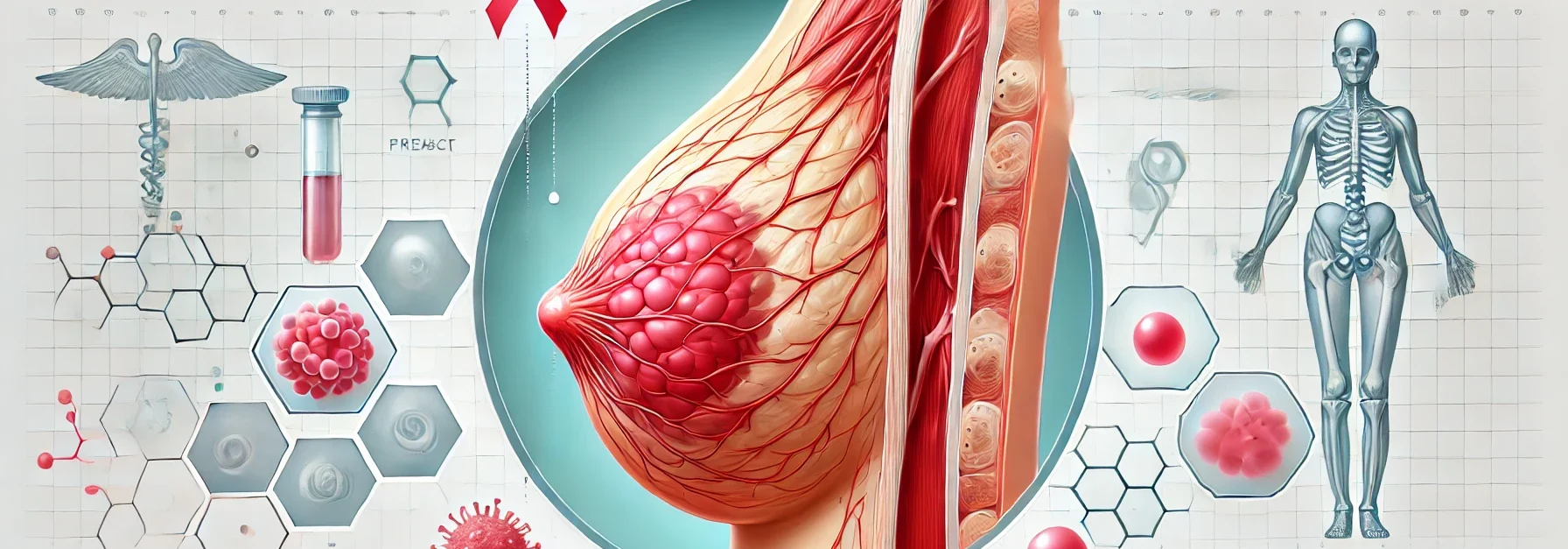What is Breast Cancer?
Breast cancer is a disease in which cells in the breast grow uncontrollably. It can develop in different parts of the breast but most commonly originates in the milk ducts (ductal carcinoma) or lobules (lobular carcinoma). Although breast cancer primarily affects women, men can also develop the disease. With early detection and appropriate treatment, survival rates significantly improve.
Understanding Breast Cancer
Breast cancer arises due to genetic mutations that lead to abnormal cell growth in the breast tissue. These cells can form a tumor, which may be benign (non-cancerous) or malignant (cancerous). Malignant tumors have the potential to spread (metastasize) to other parts of the body, making early intervention crucial.
Breast cancer is classified into several types, with the most common being:
- Invasive Ductal Carcinoma (IDC): Begins in the milk ducts and spreads to surrounding tissues.
- Invasive Lobular Carcinoma (ILC): Starts in the lobules and can spread to nearby tissues.
- Ductal Carcinoma In Situ (DCIS): A non-invasive form where abnormal cells are contained within the ducts.
- Triple-Negative Breast Cancer (TNBC): Lacks estrogen, progesterone, and HER2 receptors, making it more challenging to treat.
- HER2-Positive Breast Cancer: Overproduces the HER2 protein, which promotes cancer growth.
- Inflammatory Breast Cancer: A rare but aggressive type that causes swelling and redness.
Causes and Risk Factors of Breast Cancer
The exact cause of breast cancer remains unknown, but various risk factors can increase the likelihood of developing the disease:
Genetic and Biological Factors
- Genetic mutations: Inherited mutations in genes like BRCA1 and BRCA2 significantly raise breast cancer risk.
- Family history: Having a close relative with breast cancer increases one’s risk.
- Age: The risk rises with age, particularly after 50.
- Personal history of breast cancer: A previous diagnosis elevates the chances of recurrence.
- Dense breast tissue: Higher density increases the risk of developing cancer and makes tumors harder to detect on mammograms.
Hormonal and Lifestyle Factors
- High estrogen levels: Prolonged exposure to estrogen due to early menstruation (before 12), late menopause (after 55), or hormone replacement therapy can contribute to breast cancer development.
- Reproductive history: Women who have their first pregnancy after 30, never give birth, or do not breastfeed may have an increased risk.
- Obesity: Excess body fat, especially post-menopause, raises estrogen levels and inflammation.
- Smoking and alcohol consumption: Regular intake increases cancer risk.
- Radiation exposure: Prior radiation therapy, especially to the chest area, can contribute to the risk.
Symptoms of Breast Cancer
Recognizing the symptoms of breast cancer is crucial for early detection. Common signs include:
- A lump or thickening in the breast or underarm
- Changes in breast size, shape, or contour
- Nipple discharge, possibly containing blood
- Inverted nipple or nipple pain
- Redness, dimpling, or puckering of breast skin
- Persistent breast pain or tenderness
Not all lumps are cancerous, but any unusual change should be evaluated by a healthcare provider.
Screening Process for Breast Cancer
Regular screening helps detect breast cancer early, improving treatment outcomes. Screening methods include:
- Mammogram: A low-dose X-ray that can detect tumors before symptoms appear. It is recommended annually for women over 40 or earlier for those with a high risk.
- Clinical breast exam: A healthcare professional manually checks for lumps or abnormalities.
- Breast self-exam: Women should regularly examine their breasts for changes, though this is not a substitute for professional screening.
Diagnosis Process of Breast Cancer
If an abnormality is detected, further diagnostic tests confirm whether cancer is present:
- Ultrasound: Uses sound waves to differentiate between solid masses and fluid-filled cysts.
- Biopsy: A tissue sample is extracted and analyzed for cancer cells.
- MRI Scan: Provides detailed imaging to assess the spread of cancer.
- Genetic Testing: Determines if inherited mutations like BRCA1 or BRCA2 are present.
Stages of Breast Cancer and Treatment Options
Breast cancer treatment depends on the stage and type of cancer. Staging is classified as follows:
Stage 0 (Non-invasive/Carcinoma in Situ)
- Treatment: Surgery (lumpectomy or mastectomy), radiation therapy.
Stage I & II (Early-stage)
- Treatment: Surgery (lumpectomy or mastectomy), chemotherapy, radiation therapy, and/or hormone therapy.
Stage III (Advanced but localized)
- Treatment: More aggressive chemotherapy, targeted therapy, surgery, and radiation therapy.
Stage IV (Metastatic)
- Treatment: Focuses on controlling cancer spread with systemic treatments like chemotherapy, targeted therapy, immunotherapy, and hormone therapy.
Common Breast Cancer Treatments
- Surgery: Lumpectomy (removing the tumor) or mastectomy (removing one or both breasts).
- Radiation Therapy: Uses high-energy rays to destroy cancer cells.
- Chemotherapy: Drug therapy that kills cancer cells or stops them from growing.
- Hormone Therapy: Blocks hormones like estrogen that fuel certain breast cancers.
- Targeted Therapy: Attacks specific cancer cell proteins, such as HER2-positive treatments.
- Immunotherapy: Boosts the immune system to fight cancer.
When to Consult a Specialist?
It’s essential to consult a specialist if you:
- Discover a new lump or change in breast tissue.
- Have persistent breast pain or nipple discharge.
- Have a strong family history of breast cancer.
- Notice changes in breast shape, texture, or skin appearance.
Prevention and Lifestyle Modifications
While breast cancer cannot be entirely prevented, the following measures can reduce the risk:
- Maintain a healthy weight: Obesity is linked to increased risk.
- Exercise regularly: At least 150 minutes of moderate activity per week.
- Limit alcohol intake: Excessive drinking raises cancer risk.
- Quit smoking: Smoking is a known carcinogen.
- Eat a balanced diet: A diet rich in fruits, vegetables, lean protein, and whole grains supports overall health.
- Breastfeed if possible: Breastfeeding has been linked to lower breast cancer risk.
- Regular screenings: Especially for high-risk individuals.
Frequently Asked Questions (FAQs)
1. Can men develop breast cancer?
Yes, although rare, men can develop breast cancer. The symptoms and treatments are similar to those in women.
2. Is breast cancer hereditary?
Yes, inherited genetic mutations, particularly in BRCA1 and BRCA2 genes, increase the risk.
3. Can breast cancer be prevented?
While it cannot be entirely prevented, risk reduction strategies such as maintaining a healthy lifestyle, limiting alcohol intake, and undergoing regular screenings can help.
4. Does breast cancer always cause a lump?
No, some cases present with skin changes, nipple discharge, or breast pain instead of a lump.

